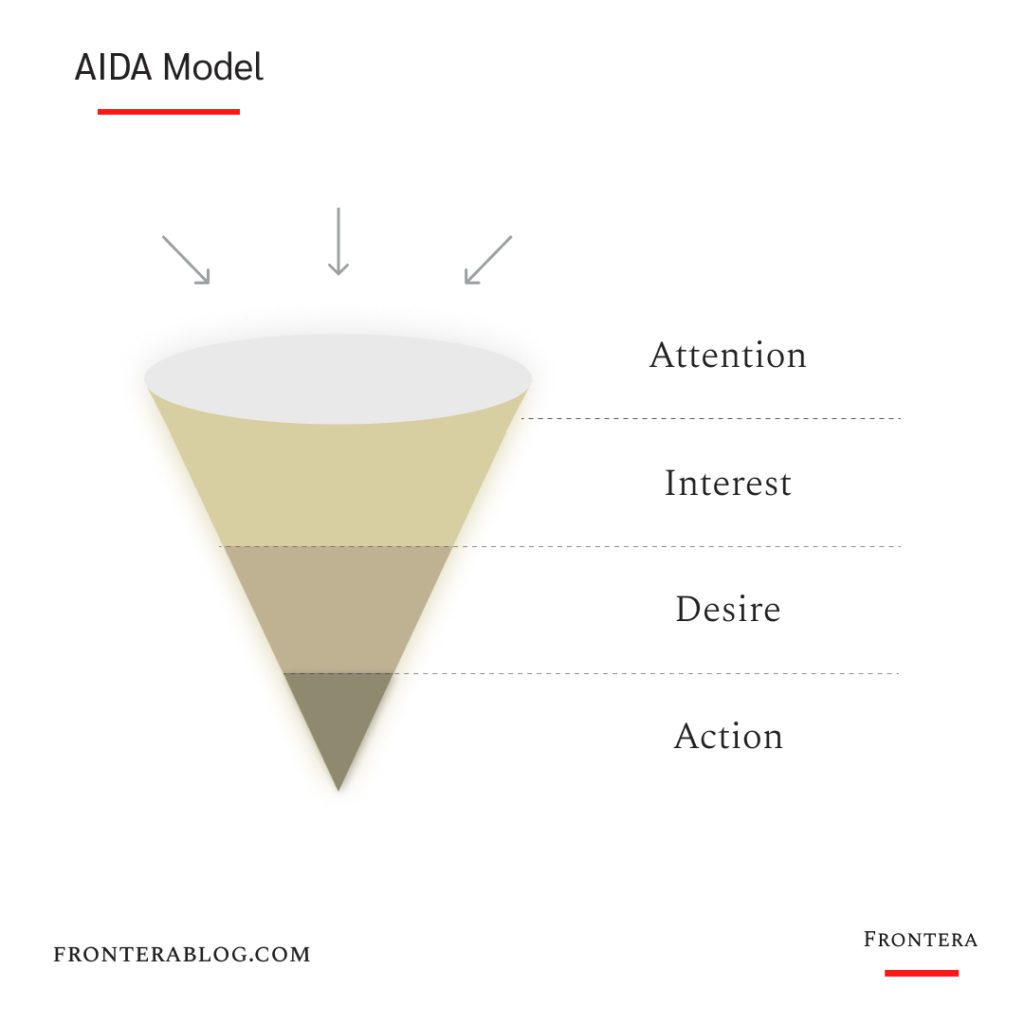Thinking in funnels is a mental model that breaks down your goals into different stages. So you can improve the conversion at each stage to achieve the best possible outcomes.
We’ll start with a marketing story from the 1890s to understand how it was born. And finish with how to think in funnels.
Let’s go.
In 1898, Elias Elmo Lewis created a formula that changed marketing forever.
He had an advertising agency.
And he wrote newspaper ads for his clients — which was the main channel to reach potential customers before radio and TV.
Like any advertiser, Lewis wanted to sell more.
Most of his peers at the time believed writing effective ads was art.
So they didn’t follow any methodology.
They trusted their guts.
But intuition was not good enough for Lewis.
He wanted a formula.
And what do you do when you think everyone is wrong but you are right?
You create your own way.
And that’s what Lewis did.
He thought about the stages customers go through with ads.
When they opened the page in the newspaper, they saw the ad’s headline first.
If they didn’t find it interesting, the rest didn’t matter.
They skipped the ad.
So he realized the first step to a successful ad was to get attention with eye-catching headlines and images.
But that was not it.
If the headline caught attention but the copy was boring or hard to understand, customers stopped reading.
So he realized the second step was to keep the reader’s attention.
And if they read everything but didn’t find the product appealing, they didn’t purchase it.
So persuading readers by creating a desire and an irresistible offer were the last two stages.
After going through it all, he summarized his formula for writing ads that sell:
“Attract attention, maintain interest, create desire, get action.”

From ads to everywhere
Lewis’s method got famous with its acronym: AIDA.
He created it to sell more with his ads, but later he realized it also applies to general marketing.
And that’s how the marketing funnel we know today was born.
The method was useful.
And the funnel metaphor was sticky.
So people adapted it to different areas: sales, project management, hiring…
I even used it to explain how information turns into wisdom.
But now instead of focusing on a specific funnel, let’s take “thinking in funnels” as a mental model.
So you can use it to achieve different goals regardless of domain.
How to think in funnels in three steps:
1. Map the stages
First, do what Lewis did with his ads.
Think through the stages of what you want to achieve.
Let’s say you want your company to make more innovative products.
Great.
What are the stages of it?
- You generate product ideas
- You test some by creating minimum viable products or prototypes
- And some of them become successful products
You see how it immediately shows you steps to work on.
If you don’t generate enough ideas, you can’t innovate.
Or if you generate many ideas in your company but don’t test any, you can’t turn them into successful products.
So even a simple funnel will show you what to improve on.
2. Normalize failure
One thing I like about funnels.
You have to normalize failure.
Let me explain with the same example.
When you generate product ideas, you know you can’t test them all.
Some will be bad ideas, and some others will be too expensive to test.
So there will be some leak in the funnel.
And that’s okay.
When you visualize it as a funnel with a conversion rate in each step, failure becomes a part of the process.
Not something to avoid.
Jeff Bezos explained it perfectly in an interview:
“There are two ways of building a business.
Many times, you aim, aim, aim, and then shoot.
Or you shoot, shoot, shoot, and then aim a little bit. That is what you want to do here.
Don’t spend a lot of time on analysis and precision. Keep trying stuff.”
3. Improve conversion
Here’s another quote, this time from management legend Peter Drucker.
“If you can’t measure it, you can’t manage it.”
Luckily, funnels turn everything into a numbers game.
Imagine you want to get sponsors for an event or your newsletter.
So you’ll send cold emails to contacts from different brands.
Most people would do it without following a methodology like Lewis’s advertising peers in the 1890s.
But you know better, so you decide to think in funnels.
What are the stages of getting a sponsorship?
- Cold emails sent
- Replies received
- Sponsorships sold
You could add a few more steps to detail it.
But let’s keep it simple.
You know not everybody will reply back or buy a sponsorship.
Let’s say you sent 100 emails, 20 of them replied, and 3 of them bought it.
Now you have conversion rates for each step.
20% reply rate for cold mail, 3% sales conversion rate.
Use it as a benchmark.
And make experiments to improve the conversion at each step.
In this example, you could test:
- Different subject lines for the first email
- Different copy to explain the benefit of sponsorship
- Different methods to close the sale after a reply is received
And these experiments would take you closer to the best possible results.
If you manage to get the conversion rate from 3% to 6%, that doubles your revenue.
Or in the previous example, if you find a way to test more product ideas, it drastically improves your chances of having new successful products.
So funnels are useful tools beyond marketing.
When others leave things to chance with intuition, think in funnels to achieve better outcomes.
–
Enjoyed this article?
Then you’ll love the How Brands Win Newsletter.
Get the “5 Mental Models to Differentiate Your Business” guide when you join. It’s free.
